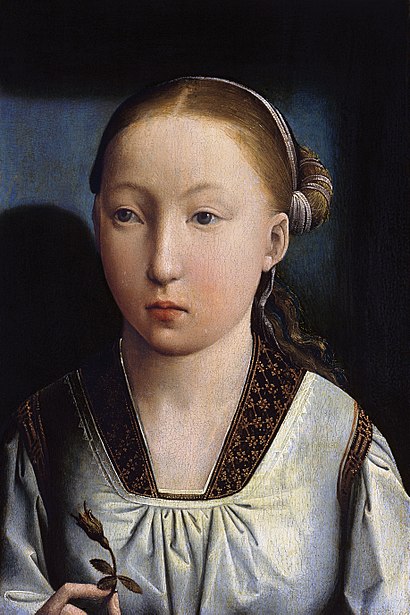 |
| Katharine as a young girl |
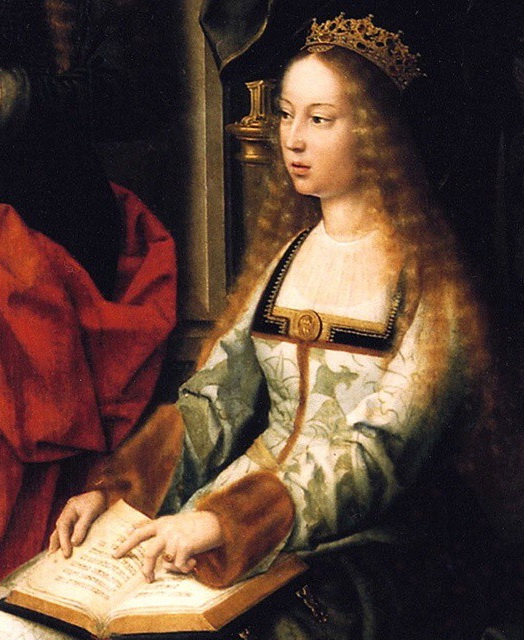 |
| Isabella I |
At age three, Katharine was betrothed to Prince Arthur of England. It was a major coup for the English. King Henry VII occupied the throne by right of conquest, not by lineage, and some royal houses refused to recognize the Tudor rule. Katharine actually had a stronger claim to the English throne than did the prince she was engaged to marry. She was descended from the legitimate children of John of Gaunt, while the Tudors were descended from the illegitimate children. The Tudors' ancestors had been legitimized later, but were forever barred from inheriting the throne. However, Henry Tudor had not inherited it. He had won it in battle. Having the deeply respected House of Trastámara agree to marry one of their Infantas into the Tudor family gave the fledgling dynasty some much-needed respectability.
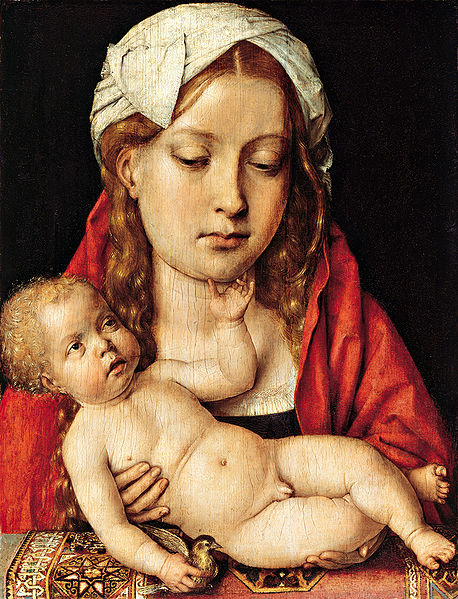 |
| Katharine as the Virgin Mary by Michael Sittow |
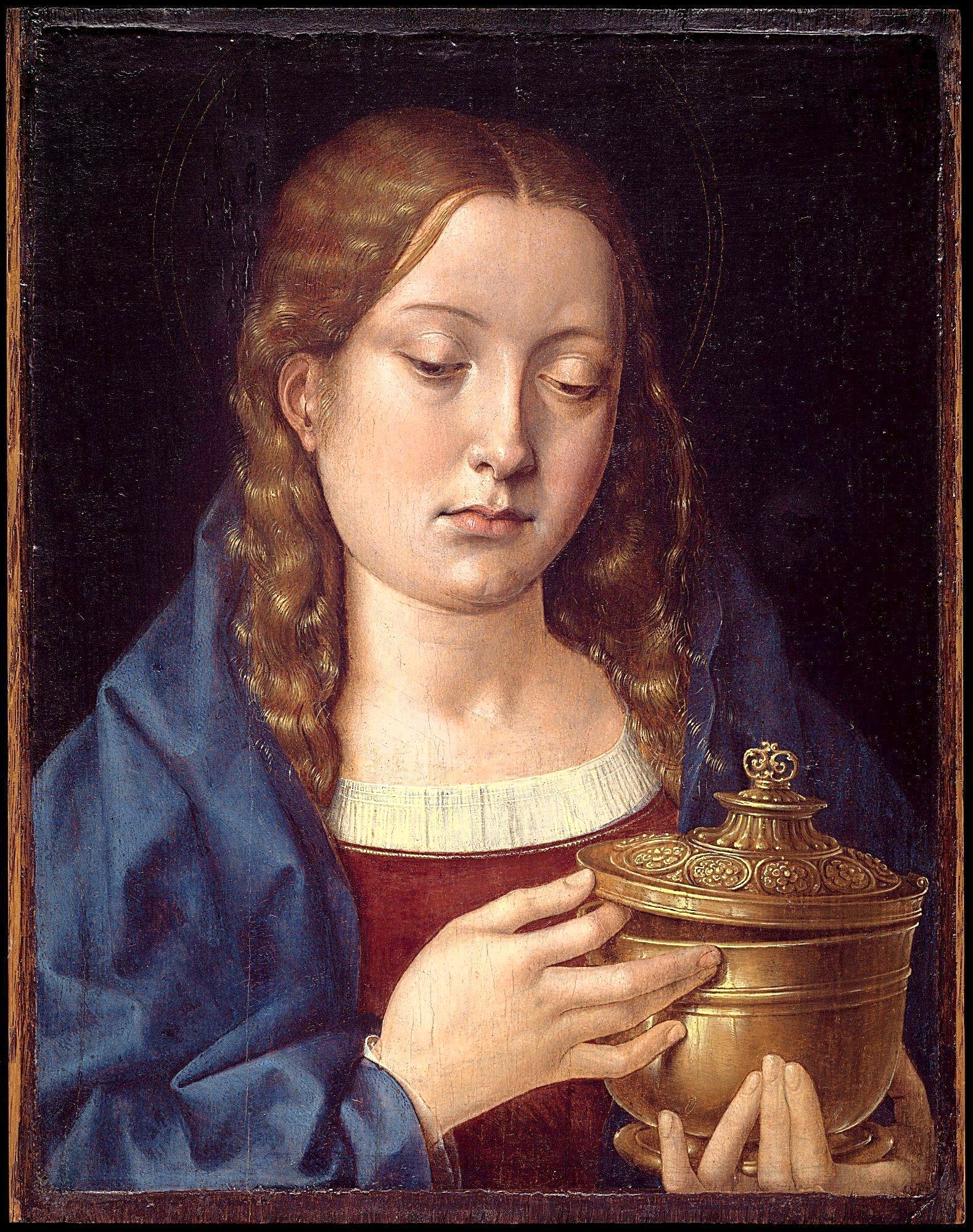 |
| Katharine as Mary Magdalene by Michael Sittow |
As a result, Katharine was taught French, Latin, and Greek, aside from her native Spanish. Her curriculum also included canon law, which she would put to use a few decades later. Along with her religious and secular instruction, Katharine was also taught the domestic arts. She, her mother, and her sisters, made every bit of Ferdinand's clothing.
 |
| Katharine? by Michael Sittow Source: Wikipedia Commons |
This portrait to the left was long believed to be one of Katharine as a teenager, but it has now been suggested it could be of Mary Tudor Brandon, sister of King Henry VIII. She wears a necklace of Ks interspersed by Tudor roses, but the K may not stand for "Katharine," but for "Karolus" the Latin name of Charles V, to whom Mary was betrothed at the time. You can read an interesting analysis of the arguments for and against the painting's identification here.
Katharine exchanged polite letters with her betrothed until he was fifteen and judged old enough to be a husband. Katharine was sixteen. She departed Spain for the last time on September 27, 1501, accompanied by her servants and a vast dowry of ₤100,000, though it was only half of what was agreed.
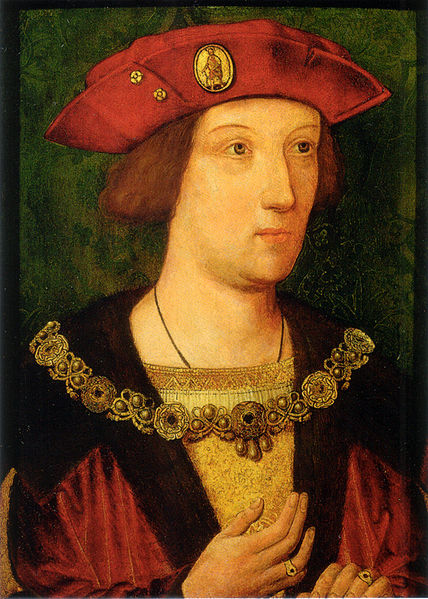 |
| Arthur, Prince of Wales |
"Ah, but the lady! Take my word for it, she thrilled the hearts of everyone: she possesses all those qualities that make for beauty in a very charming girl. Everywhere she receives the highest of praises; but even that is inadequate."
She and Arthur were quickly married, in an elaborate ceremony. A raised stage, six hundred feet long, had been built, so the excited English people could catch a glimpse of Arthur's new bride. The royal couple were both dressed all in white for the ceremony, which was preceded by a reading of the papal dispensations (Katharine was actually the third cousin of Henry VII) and then the marriage treaty with its conditions, provisions, and the dowry agreement. Afterward, they were wed.
 What happened over the next couple of months is a historical mystery. On the morning after his wedding night, Prince Arthur called for ale, bragging he had a large thirst for he had been in the "midst of Spain" the night before. He later said it was "good pastime" to have a wife.
What happened over the next couple of months is a historical mystery. On the morning after his wedding night, Prince Arthur called for ale, bragging he had a large thirst for he had been in the "midst of Spain" the night before. He later said it was "good pastime" to have a wife. Katharine spent the day after the wedding in seclusion, as was proper for an English bride. The following day, she went to St. Pauls to give thanks to God "... that so prosperously His Goodness had suffered everything of this laudable [marriage] to be brought to its most laudable conclusion.”
The Prince's groom of the privy chamber, William Thomas, reported that the Prince visited Katharine's bedchamber often.
"[Thomas]... made [Arthur] ready to bed . . . and conducted him clad in his night gown unto the Princess’s bedchamber door often and sundry times . . . and that at the morning he received him at the said doors . . . and waited upon him to his own privy chamber.”
Katharine later claimed Arthur only spent seven nights with her.
What happened on those nights Arthur went to Katharine's chamber? She would later swear the marriage had never been consummated. Her duenna (nursemaid), Doña Elvira, would swear, as well, going as far as to say if Katharine was examined by competent persons, they would find her to be virgo intacta.
But if it was not consummated, why? Arthur was thought capable of being a husband by his family. Despite later speculations by some historians, there is no recorded evidence that Arthur was sickly; Katharine, herself, never mentioned it when she was insisting the marriage had remained unconsummated, and surely she would have, if Arthur had been incapable of sexual intercourse.
 |
| A tapestry with an image of Arthur and Katharine |
King Henry VII did not intend to send Katharine along with Arthur to Wales. It's possible Henry was thinking of the expense of a full royal household for the young couple. Henry was careful with money. Not stingy as is sometimes alleged of him, but careful in his expenses. It would be less expensive to house Katharine with the king and queen while Arthur went off with just his own household.
But Katharine wouldn't hear of it. Through her tutor-- who had accompanied her to England and now served as her confessor-- Katharine insisted “on no condition in the world should [the king] separate them, but send her with her husband.” She told the king she would be in despair if he separated her from Arthur, and furthermore, her mother and father would be displeased. Everyone wanted Katharine to produce an heir as soon as possible; that couldn't happen if Arthur was in Wales. King Henry acquiesced and the princess was sent off with her new husband to Ludlow Castle to rule over their new court.
Six months after the marriage, both Katharine and Arthur fell ill. It's believed to have been "The Sweat," that mysterious English ailment. There were rumors of an outbreak of The Sweat in the area, but there was no discussion of moving the Prince and Princess to an uninfected area, so it must not have been seen as a serious threat. Indeed, it seems they went on with life as usual, even participating in the Holy Week ritual of washing the feet of the poor.
Arthur died on Easter Sunday, 1502. He was buried three weeks later in Worcester Cathedral. Katharine was still too ill to participate in any of the funeral arrangements.
 Richard Grafton wrote:
Richard Grafton wrote:With great funeral obsequies he was buried in the cathedral church of Worcester. After his death the name of prince belonged to his brother the duke of York, since his brother died without his issue, and so without being thus created he ought to be called, unless some apparent cause was a let or obstacle to it. But the duke, suspecting that his brother's wife was with child, as was thought possible by the expert and wise men of the prince's council, was by a month or more delayed from his title, name and pre-eminence, in which time the truth might easily appear to women.
But it was soon obvious Katharine was not with child. She was returned to London, lodged in Durham House, uncertain of her fate.
 |
| Katharine and Patience by Charles Robert Leslie |
Poverty, of course, is far different for a princess than for a peasant, but there's no doubt Katharine was in real emotional distress. She continually wrote to her father, pleading for his help.
Eventually, Henry and Ferdinand worked out a deal to marry Katharine to Arthur's younger brother, Prince Henry. There was the matter of getting a dispensation for the union-- canon law held it was incestuous for a man to marry his brother's widow... without a dispensation, that is. Katharine insisted on the non-consummation, and so the wording was debated a bit, with one of the papal bulls that was issued stating that the marriage had "perhaps" been consummated.
_by_English_School.jpg/395px-Henry_VIII_(reigned_1509-1547)_by_English_School.jpg) |
| Prince Henry, Later Henry VIII |
Prince Henry was five years younger than Katharine and unable to wed yet. Katharine could only wait.
For the next five years, Katharine held on as best she could, hoping for her marriage to Prince Henry to free her from the difficult situation she was in. She was frequently ill, perhaps from the stress, and from the fasting she did to appeal to God to intervene. Some scholars have suggested Katharine might have had an eating disorder, which could have contributed to her later infertility.
Her father, to give her some formal status at the court, appointed Katharine as the ambassador to Spain. Katharine was the first woman in England to ever hold such a position, and it seems she did her work quite well, despite her youth. If Henry VII had thought Katharine would be easily bullied and submissive to his will, he was mistaken.
In 1505, Henry's father had him formally repudiate the betrothal, which he could do since it had been made without his consent as a child. But Katharine still did not return to Spain. Her father likely did not want the expense of supporting her, either, nor of having to pay out another dowry to marry her off.
The king died in 1509, and one of Henry's first acts was to marry Katharine. Why did he do it? We don't know. He claimed it was his father's last request, though that is unlikely. Did he think it was romantic to rescue the princess in distress? Was he in love with her? In a song he wrote, Henry said he loved where he did wed, and rode in jousts with Katharine's colors, and the motto, "Sir Loyal Heart." Whatever the reason, they wed quietly in the king's closet in Greenwich palace, and a new chapter in Katharine's life began.



No comments:
Post a Comment